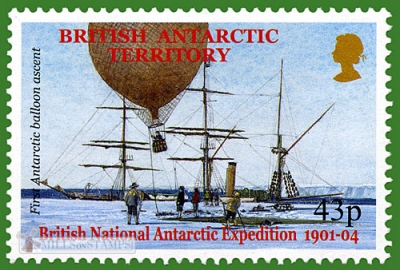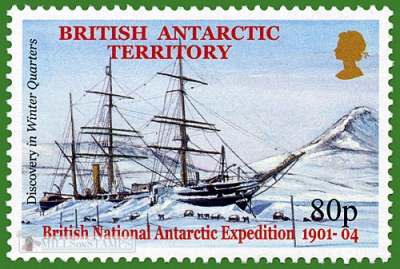-
Centenary of British National Antarctic Expedition (1901-1904)
British Antarctic Territory 2001.12.05
In issue: Stamp(s): 6
Printing: lithography on watermarked paper
-
Number by catalogue: Michel: 321 Yvert: 335 Scott: 303
Perforation type: 14x14
Subject:
43 pence. A sailing vessel "Discovery"* and the first Antarctic balloon ascent
Topics: Various Wind turbines
-
Number by catalogue: Michel: 324 Yvert: 338 Scott: 306
Perforation type: 14x14
Subject:
80 pence. A sailing vessel "Discovery" trapped in ice
Additional:
 *The RRS Discovery was the last wooden three-masted ship to be built in Britain. Designed for Antarctic research, she was launched in 1901. Her first mission was the British National Antarctic Expedition, carrying Robert Falcon Scott and Ernest Shackleton on their first, successful journey to the Antarctic, known as the Discovery Expedition. She is now the centrepiece of visitor attraction in her home, Dundee.
*The RRS Discovery was the last wooden three-masted ship to be built in Britain. Designed for Antarctic research, she was launched in 1901. Her first mission was the British National Antarctic Expedition, carrying Robert Falcon Scott and Ernest Shackleton on their first, successful journey to the Antarctic, known as the Discovery Expedition. She is now the centrepiece of visitor attraction in her home, Dundee.On 16 March 1900, construction on the Discovery began in Dundee, Scotland, by the Dundee Shipbuilders Company. She was launched into the Firth of Tay on 21 March 1901 by Lady Markham, the wife of Sir Clements Markham who was President of the Royal Geographical Society.
Discovery had coal-fired auxiliary steam engines, but had to rely primarily on sail because the coal bunkers did not have sufficient capacity to take the ship on long voyages. She was rigged as a barque. Also on a nose of a sailing vessel has been developed wind electric generator which if necessary could be spread out or combined.According to Shackleton, the ship was a bad sailer, and carried too much sail aft and not enough forward; while Scott worried that the design of the ship's hull was unsuitable for work in pack ice. The ship had a massively built wooden hull designed to withstand being frozen into the ice. The propeller and rudder could be hoisted out of the way to prevent ice damage. Iron shod bows were severely raked so that when ramming the ice they would ride up over the margin and crush the ice with deadweight. The Discovery rolled badly in the open sea where the flat shallow hull, built with no protuberances to work well in ice, provided minimal stability in heavy seas.
Five months after setting sail on 6 August 1901 from the Isle of Wight, she sighted the Antarctic coastline on 8 January 1902. During the first month Scott began charting the coastline. Then, in preparation for the winter, he weighed anchor in McMurdo Sound. Unfortunately, this was where the ship would remain, locked in ice, for the next two years; the expedition had expected to spend the winter there and to move on in the spring. Despite this, the Expedition was able to determine that Antarctica was indeed a continent, and they were able to relocate the Southern Magnetic Pole. Scott, Shackleton and Edward Wilson also achieved a Furthest South of 82 degrees 18 minutes. The ship was eventually freed on 16 February 1904 by the use of controlled explosives which allowed the ice to be moved away by butting and shunting, thus assisting in the break up of the ice. RRS Discovery finally sailed for home, arriving back at Spithead on 10 September 1904.
Topics: Various Wind turbines



